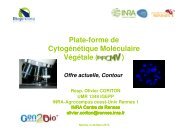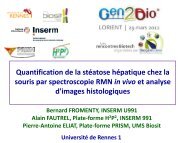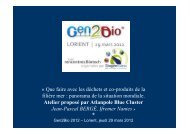In-vivo - Biogenouest
In-vivo - Biogenouest
In-vivo - Biogenouest
Create successful ePaper yourself
Turn your PDF publications into a flip-book with our unique Google optimized e-Paper software.
IN VIVO IMAGINGWITH CELLULAR RESOLUTIONNantesJeudi 28 MARS 2013Programme des Ateliers thématiquesGen2Bio 2013 – Nantes, jeudi 28 mars 2013Les ateliers durent 35 minutes et ont lieu en parallèle des conférences en amphi et aux mêmes horaires. Vous pouvez participer à 1 ou plusieurs ateliers(7 maximum). Attention : Pour nous permettre d'organiser au mieux la journée, l'inscription aux ateliers est obligatoire.H Gharbi | Gen2Bio | 28 Mars 2013 | Nantes
AgendaINTRODUCTION SYSTEM DESCRIPTION APPLICATIONSCANCER RESEARCH NEUROSCIENCE JOIN US2H Gharbi | Gen2Bio | 28 Mars 2013 | Nantes
Our Strength, Our MissionWe find our strength in our solid background inmultidisciplinary astrophysicsOur mission is to improve the standard-of-carethanks to our unique probe-basedendomicroscopy technology3MKEA_CORP v0.9 © 2011 Mauna Kea Technologies
Mauna Kea TechnologiesA fast growing Medical Device companyfrench!Leader in the endomicroscopy fieldCellvizio: a unique probe-basedconfocal laser endomicroscopysolutionBased in Paris and Atlanta, presence in Europeand Asia.Listed on NYSE-Euronext, compartment Bunder the ticker MKEA.4
What is Cellvizio ?• World’s smallest Flexible Microscope• Designed for in <strong>vivo</strong> imaging• For Researchers & Clinicians• Point Of Care Imaging StationClinical• Biliary structures• Colon, IBD• Lung• Barrett’s Esophagus• Urinary tract• FDA, CE, CPT CodesResearchWhat is ? EmpowewithCellvizio® is the smallest video-microscope. • Functional ImagingIt offers High-resolution, confocal imaging and • ColocalizationDeep brain improvides in <strong>vivo</strong> & in situ imaging.• Structure-Function in freely-moviLOW INVASIVENESSTECHNOLOGICAL BREAKTHROUGHEASY-TO-USE, TURN-KEY SOLUTION• Neuroscience• Cancer research• ...135H Gharbi | Gen2Bio | 28 Mars 2013 | Nantes
How about Real-time information?What is ?Many Steps in Pathology LaboratoriesMany Opportunities of error<strong>In</strong>creasing needs:Safety, Workflow, Quality ManagementCellvizio® is the smallest video-microscope.It offers High-resolution, • Real-Time confocal answers imaging andprovides in <strong>vivo</strong> & in situ imaging.• High-resolution1LOW INVASIVENESS• in <strong>vivo</strong> & in situTECHNOLOGICAL BREAKTHROUGH• Point Of Care stationEASY-TO-USE, TURN-KEY SOLUTION• Easy-to-use• Turnkey solutionCarrefour Pathologie 2010 v337H Gharbi | Gen2Bio | 28 Mars 2013 | Nantes
Experience Optical BiopsyOptical BiopsyTissue BiopsyFRONT VIEW<strong>In</strong>-<strong>vivo</strong>MicroscopicMinimally invasiveReal-time imagingTRANSVERSE VIEWEx-<strong>vivo</strong>Microscopic<strong>In</strong>vasiveLate imaging82H Gharbi | Gen2Bio | 28 Mars 2013 | Nantes
Where does Cellvizio Lab fit?1 2Microscopie à fluorescenceTRIPLE MARQUAGE• High-speed Live Cell Imaging a• The Fastest True Confocal Sys• Leading in Multispectral Imagi• <strong>In</strong>telligent and <strong>In</strong>tuitive <strong>In</strong>terfaMicroscopicResolutionConfocal2-photonSTEDCARSDAPI CHROMOSOMESBODIPY FL TUBULINETEXAS RED ACTINEKératinocyte1What is ? Empower yoCellvizio® is the smallest video-microscope.It offers High-resolution, confocal imaging andprovides in <strong>vivo</strong> & in situ imaging.LOW INVASIVENESS• Real-Time• High-resolutionTECHNOLOGICAL BREAKTHROUGH• in <strong>vivo</strong> & in situEASY-TO-USE, TURN-KEY SOLUTION• Minimally invasivewithDeep brain imagingin freely-moving miceMacroscopicResolutionin vitro32in vitroin vitro in vitroin vitroin vitroin vitro in <strong>vivo</strong>in <strong>vivo</strong> in <strong>vivo</strong>in <strong>vivo</strong>in <strong>vivo</strong> in <strong>vivo</strong>in <strong>vivo</strong>in <strong>vivo</strong>in vitroin <strong>vivo</strong>31Laser Scanning UnitConfocal Microscope488 or 660 nm excitation beamSingle-photon detection (APD)Handy, turn-key, easy-to useImageCell SoftwareReal-time image processingQuantification featuresFramerate up to 200 fpsLSU controlin <strong>vivo</strong>22ProFlex MiCROprobesDesigned for different applicationsHigh Resolution: up to 1.4 mThin diameter: down to 300 m LIGHTEST IMPLANTS Only 0UltrasoundMRIPET/CTSPECTFluo/VisibleNear IRLOW INVASIVE MICROPROB*Available in 350 m or 470 m (hardened tip)9<strong>In</strong>vasiveH Gharbi | Gen2Bio | 28 Mars 2013 | NantesNoninvasive
SYSTEM DESCRIPTIONLaser Scanning Unit | Confocal Microprobes | Quantification features11H Gharbi | Gen2Bio | 28 Mars 2013 | Nantes
s ? Confocal Laser Empower endo-microscopeyour experimentswiththe smallest video-microscope.h-resolution, confocal imaging and<strong>vivo</strong> & in situ imaging.ENESSCAL BREAKTHROUGHDeep brain imagingin freely-moving mice !, TURN-KEY SOLUTION3A FULL SOLUTIONDedicated set of toolsFits the workflowWorks with anystereotaxic set-upnning Unitscopeexcitation beamdetection (APD)y, easy-to12useH Gharbi | Gen2Bio | 28 Mars 2013 | Nantes2«Each fiber acts as a point source»and a point detector or pinhole2 ProFlex MiCROprobesDesigned for different applicationsHigh Resolution: up to 1.4 mThin diameter: down to 300 m LIGHTEST IMPLANTS Only 0,3gLOW INVASIVE MICROPROBE Only 350m in diameter*
s ? Confocal Laser Empower endo-microscopeyour experimentsthe smallest video-microscope.h-resolution, confocal imaging and<strong>vivo</strong> & in situ imaging.ENESSCAL BREAKTHROUGHwithDeep brain imagingin freely-moving mice !, TURN-KEY SOLUTION3A FULL SOLUTIONDedicated set of toolsFits the workflowWorks with anystereotaxic set-upLASER SCANNING UNIT• Confocal Microscope2• 488 and 660 nm excitation beam• Dual Band excitation/Detection• Highly sensitive (APD)• Handy, turn-key, easy-to-useCONFOCAL MICROPROBES• Designed for different applications• High Resolution: up to 1.4 µm• Diameter down to 300 µm• Thousands fiber-optics• FlexibleACQUISITION SOFTWARE• Real-Time video recording• Quantification features• Frame rate 12-200 fps• LSU control• Various exportsnning Unitscopeexcitation beamdetection (APD)y, easy-to13useH Gharbi | Gen2Bio | 28 Mars 2013 | Nantes2 ProFlex MiCROprobesDesigned for different applicationsHigh Resolution: up to 1.4 mThin diameter: down to 300 m LIGHTEST IMPLANTS Only 0,3gLOW INVASIVE MICROPROBE Only 350m in diameter*
Cellvizio Line-up for Researchers488 660EXCITATIONSingle Band488 nmSingle Band660 nmDual Band488 + 660 nmDETECTIONRange505 - 700 nmRange680 - 900 nmFirst Line502 - 633 nmSecond Line673 - 800 nmFRAME RATEReal-time recordingFrame rate:8 - 12 fpsHyperScan®:Up to 200 fpsReal-time recordingFrame rate:8 - 12 fpsHyperScan®:Up to 200 fpsReal-time recordingFrame rate:9 fpsAdvanced:Up to 50 fpsEXPORTImage:png, bmp, jpeg, tiff, mhdVideo:avi, mpeg, mp4, swfImage:png, bmp, jpeg, tiff, mhdVideo:avi, mpeg, mp4, swfImage:png, bmp, jpeg, tiff, mhdVideo:avi, mpeg, mp4, swf14H Gharbi | Gen2Bio | 28 Mars 2013 | Nantes
Various microprobes....Diameter300 µmHighWorkingDistanceWorking DistanceWDResolution1,4 µmOptical SectioningWD+WD++....for diverse applications....for diverseapplications15H Gharbi | Gen2Bio | 28 Mars 2013 | Nantes
Confocal MicroprobesA group of fibers shows an egg boxprofile or honeycomb pattern.Relevant information must beretrieved from this pattern.SSeriesSurfaceImagingModelCerboFlexCerboFlex JS-300*S-0650*S-1500ApplicationsDeep brain imaging, designedfor permanent implantationon freely moving micePart of the NeuroPak solutionTipDiameter(mm)0,350,47LateralResolution(µm)OpticalSectioning(µm)WorkingDistance(µm)Max FieldOf view(µm)3,3 15 0 325Brain, deep brain in mice,other organs at depth if lowinvasiveness is mandatory 0,3 3,3 15 0 300Brain, deep brain in rats,other organs at depth if lowinvasiveness is mandatory 0,65 3,3 15 0 600General applicability, can beused to check fluorescencesensitivity in most targets 1,5 3,3 15 0 600MSeriesHi-ResImagingUltraMiniOMiniO/30MiniO/100Vessels, angiogenesis, cellfate, cell morphology, utilitydepends on cell layerthickness and invasivenessVessels, angiogenesis, cellfate, cell morphology, utilitydepends on cell layerthickness and invasivenessVessels, angiogenesis, cellfate, cell morphology, utilitydepends on cell layerthickness and invasiveness2,6 1,4 10 60 2404,2 1,4 10 30 2404,2 1,4 10 100 240ZSeriesDepthImagingZ-1800Mini-ZBlood flow through the vessel(without penetration) imagedeeper cell layers of tumor,organ or tissue1,8 3,5 70Cavities, eye 0,94 3,5 30100/170at488/66050/70at488/660600325> Made ofthousands fiber-optics16H Gharbi | Gen2Bio | 28 Mars 2013 | Nantes
Quantification TOOLBOXAdvanced MosaïcingKinetic AnalysisVessel Detection®Enhanced resolutionBigger field of viewFollow the probe’s trackQuantify fluorescence over timeManage multiple ROIsDirect Graph plot and exportSegment vesselsMeasure neoangiogenesisEvaluate anti-angiogenic drugs17H Gharbi | Gen2Bio | 28 Mars 2013 | Nantes
Neuron bodiesVessel branchesGFP mouse brainH Gharbi | Gen2Bio | 28 Mars 2013 | Nantes
Vessel Detection ModuleFeatures• Automatic Segmentation• Compatible with Mosaicing• Functional Capillary Density• Total Area measurements• Total Length measurements• ExportMouse Kidney VasculatureMouse MesentericVasculature Mosaic20H Gharbi | Gen2Bio | 28 Mars 2013 | Nantes
Vessel Detection ModuleFeatures• Automatic Segmentation• Compatible with Mosaicing• Functional Capillary Density• Total Area measurements• Total Length measurements• ExportMouse Kidney VasculatureMouse MesentericVasculature Mosaic20H Gharbi | Gen2Bio | 28 Mars 2013 | Nantes
Vessel Detection ModuleFeatures• Automatic Segmentation• Compatible with Mosaicing• Functional Capillary Density• Total Area measurements• Total Length measurements• ExportTotal Vessel Length: 3552 µmTotal Vessel Area: 47716 µm²Total Area: 131476 µm²Mean Vessel Diameter: 13.4 µmDiameter Standard Deviation: 2.7Functional Capillary Density - Length: 0.027 µm·¹Functional Capillary Density - Area: 0.3621H Gharbi | Gen2Bio | 28 Mars 2013 | Nantes
A Wealth of ApplicationsDeep BrainMolecular ImagingFunctional Imaging<strong>In</strong>flammationImmunologyAngiogenesisColocalizationDrug DeliveryPeriph Nervous SystemReproductive Biology<strong>In</strong>fectious diseasesGene expressionVirologyParasitologyOptogenetics[Your Application]...H Gharbi | Gen2Bio | 28 Mars 2013 | Nantes
A Wealth of ApplicationsDeep BrainMolecular ImagingFunctional Imaging<strong>In</strong>flammationImmunologyAngiogenesisColocalizationDrug DeliveryPeriph Nervous SystemReproductive Biology<strong>In</strong>fectious diseasesGene expressionVirologyParasitologyOptogenetics[Your Application]...H Gharbi | Gen2Bio | 28 Mars 2013 | Nantes
Applications Cliniques deApplications cliniques del’Endomicroscopie Confocalel’‛endomicroscopie confocaleDr Emmanuel Coron, M.D., PH.DDr Emmanuel Coron28 mars 20135 novembre 2011Dr Emmanuel Coron28 Mars 2013H Gharbi | Gen2Bio | 28 Mars 2013 | Nantes
3MICROSCOPIC VIEW:CELLVIZIO2MACROSCOPIC VIEW:1THE ENDOSCOPESUSPICIOUS AREA DETECTEDCONFOCAL MINIPROBEINSERTED IN THE CHANNELCellvizio® within the Endoscopy Suite
Main Clinical <strong>In</strong>dications...by providing real-time characterization of tissueCellvizio® is the only probe-based microscope that provides real-time characterization of tissue during endoscopy.Cellvizio® in the Gastrointestinal TractNewGastroFlex TM UHDBarrett’s Esophagussurveillance and treatmentIdentify malignant tissue (4, 5,)Guide therapeutic decisionmaking(4)CholangioFlex TMBilio-pancreatic StricturescharacterizationDetect more malignant stricturesduring ERCP procedures (1, 2, 3)Tell patients “on the spot” thatthe stricture appears nonmalignant(2) <strong>In</strong>testinal Metaplasia AdenocarcinomaHealthy Bile DuctMalignant StrictureEsophagus Biliary Duct <strong>In</strong>testine PancreasmosaicLength:4 mCompatibleoperating channel:>_ 1.2 mmLength:3 mCompatibleoperating channel:>_ 2.8 mm50 µmNONDYSPLASICDYSPLASICBENIGNCHOLANGIOCARCINOMABENIGNINFLAMMATORYRECTOCOLITISTUMORTIPMPCYSTADENOMAH Gharbi | Gen2Bio | 28 Mars 2013 | Nantes
Optical Biopsy: anywhere into the bodyEsophagusStomachPancreasBiliary ducts<strong>In</strong>testineColonrectum/anusTracheaBronchiAlveolaLiverKidneyBladderUretra
Lab inCancer ResearchH Gharbi | Gen2Bio | 28 Mars 2013 | Nantes
Molecular imagingMolecular Imaging is dedicated to thepublication of early preclinical research, withspecial attention given to molecular- andcellular-level discoveries and non-nucleartechniques such as magnetic resonanceimaging, magnetic resonance spectroscopy,ESR or EPR microscopy, optical imaging,intravital microscopy, diffuse opticaltomography and other methods that elucidatemolecular and cellular mechanisms andaccelerate understanding of biology.29H Gharbi | Gen2Bio | 28 Mars 2013 | Nantes
Molecular imagingCancer Researchand AngiogenesisCEA (F. Duconge)Multimodal biomarker distribution evaluation• nIR marker: AngioStamp®• αvβ3 integrin molecular marker• Endothelial pattern overexpressed in tumor neovessels• Angiogenesis indicator• Uptaken by Tumor Associated Macrophages30
Molecular imaging31<strong>In</strong> <strong>vivo</strong> diagnosis of murine pancreatic intraepithelialneoplasia and early-stage pancreatic cancer bymolecular imagingStefan EserPancreatic a,1 , Marlena Messer a,1 , Philipp EserCancerb , Alexander von Werder a , Barbara Seidler a , Monther Bajbouj a ,<strong>In</strong> <strong>vivo</strong> diagnosis of murine pancreatic intraepithelialRoger Vogelmann a , Alexander Meining a , Johannes von Burstin a , Hana Algül a , Philipp Pagel b , Angelika E. Schnieke c ,Irene Esposito d , Roland M. Schmid a , Günter Schneider a , and Dieter Saurneoplasia a,2and early-stage pancreatic cancer bya II. Medizinische Klinik, Technische Universität München, 81675 Munich, Germany;Eser et al, PNAS 2011b Lehrstuhl für Genomorientierte Bioinformatik and c LivestockBiotechnology, Technische Universität München, Wissenschaftszentrum Weihenstephan, 85354 Freising, Germany; and d <strong>In</strong>stitute of Pathology, TechnischeUniversität München, 81675 Munich, Germanymolecular imagingEdited by David A. Cheresh, University of California at San Diego, La Jolla, CA, and accepted by the Editorial Board May 6, 2011 (received for review January18, 2011)Pancreatic ductal adenocarcinoma (PDAC) is a fatal disease withpoor patient outcome often resulting from late diagnosis in advancedstages. To date methods to diagnose early-stage PDACare limited and in <strong>vivo</strong> detection of pancreatic intraepithelial neoplasia(PanIN), a preinvasive precursor of PDAC, is impossible.Using a cathepsin-activatable near-infrared probe in combinationwith flexible confocal fluorescence lasermicroscopy (CFL) in a geneticallydefined mouse model of PDAC we were able to detect andgrade murine PanIN lesions in real time in <strong>vivo</strong>. Our diagnosticapproach is highly sensitive and specific and proved superior toclinically established fluorescein-enhanced imaging. Translation ofthis endoscopic technique into the clinic should tremendously improvedetection of pancreatic neoplasia, thus reforming managementof patients at risk for PDAC.molecularFluorescein:in <strong>vivo</strong> imaging | early detection | carcinoma in situ | geneticallyengineered mouse model | cathepsinMorphology and extent of fibrosisProSense 680:Pancreatic cancer (pancreatic ductal adenocarcinoma, PDAC)is one of the deadliest human malignancies, with an extremelypoor 5-y survival rate below 5% (1). Because patients generallypresent with symptoms relating to late stages of the disease, diagnosisof resectable PDAC is achieved in less than 15% of cases(1). However, investigators have reported that diagnosis and resectionof early-stage PDAC (
Vasculature & AngiogenesisWhat is ? EmpowithCellvizio® is the smallest video-microscope.It offers High-resolution, confocal imaging andprovides in <strong>vivo</strong> & in situ imaging.LOW INVASIVENESSDeep braiin freely-mTECHNOLOGICAL BREAKTHROUGHEASY-TO-USE, TURN-KEY SOLUTIONMesenteric vessels13• C57 Bl/6 mouse• FITC Dextran 70kDa• Z-1800 ProFlex• 100 µm Opticalsectioning• 3,5 µm lateral resolutionPancreasvascularization1 Laser Scanning UnitConfocal Microscope488 or 660 nm excitation beamSingle-photon detection (APD)Handy, turn-key, easy-to use3 ImageCell SoftwareReal-time image processingQuantification featuresFramerate up to 200 fpsLSU control22 ProFlex MiCROprobesDesigned for different applicationsHigh Resolution: up to 1.4 mThin diameter: down to 300 mLIGHTESTLOW INV*Available in 350NormalCortex vessels• C57 Bl/6 mouse• FITC Dextran 70kDa• S-1500 ProFlex• 3,3 µm lateralresolutionPDACPancreasDuctalAdenoCarcinomaH Gharbi | Gen2Bio | 28 Mars 2013 | Nantes
PERIPHERAL NERVESMotor endplates33H Gharbi | Gen2Bio | 28 Mars 2013 | Nantes
Why Cellvizio for your experiments?CELLVIZIO LAB• <strong>In</strong> <strong>vivo</strong> imaging• Minimally invasive• One animal is its own control• Longitudinal studies on the same animal• Real time imaging• Dynamic, in situ tissue characterization1 2IN VIVO !• High-speed Live Cell Imaging a• The Fastest True Confocal Sys• Leading in Multispectral Imagi• <strong>In</strong>telligent and <strong>In</strong>tuitive <strong>In</strong>terfaIN VITROCONVENTIONAL CONFOCAL MICROSCOPY• <strong>In</strong> vitro or ex <strong>vivo</strong> studies• Requires large number of sacrificed animals• One mouse per measurement• Images fixed tissue stained at a given time• Samples34H Gharbi | Gen2Bio | 28 Mars 2013 | Nantes2
Periph al Nervous SystemEx <strong>vivo</strong> :INVESIGATION OF NERVE REGENERATIONAFTER CRUSH INJURY OF THE SAPHENOUS NERVEPost-crush outgrowth measurement, 4 days after injuryPeriodic control epifluorescencemicroscopy can only be performedon fixed tissue and with multipleanimals.<strong>In</strong> <strong>vivo</strong> & in situ :Control4 daysThy1.2-YFP16 mouseCrushed NerveAdapted from Vincent et al., 200635H Gharbi | Gen2Bio | 28 Mars 2013 | Nantes
Periph al Nervous SystemF. Wong et al. / Molecular and Cellular Neuroscience 42 (2009) 296–307Axonal and neuromuscular synaptic phenotypes in Wld S , SOD1 G93A and ostes mutant mice identifiedby fiber-optic confocal microendoscopyFrances Wong a,b, Li Fan a, Sara Wells b, Robert Hartley a, Francesca E. Mackenzie b, OyinlolaOyebode a, Rosalind Brown a, Derek Thomson a, Michael P. Coleman c, Gonzalo Blanco b,1, Richard R.Ribchester a,⁎,1301distinguishes intact from degenerating NMJs and axons in Wld S mice and ENU-phenodeviants. A–C Evidence of synaptic protection in three F1 ENU/thy1.2-after sciatic nerve section (CEMOP_S1, S2 and S5). All these phenodeviants were genetically heterozygous for Wld S . These images were all obtained fromured at 12frames/s. Movies from phenodeviants CEMOP_S3 and CEMOP_S5 are shown in Supplementary Movies 3 and 4. D: Fragmented axons wereatic nerve section in the tibial nerve of ENU-mutant CEMOP_A1 that was heterozygous for Wld S .Cellvizio imaging of NMJs and axons in WldS mice andENU-phenodeviants.s therefore constitute convincing evidence that 2%) on the incidence of spontaneous phenodeviation with synapticies an autosomal-dominant, A–C Evidence of ENU-induced synaptic protection mutaapticdegeneration,protection in three (i.e. F1 ENU/thy1.2- phenotypic outliers) YFP/Wld in Wld S/+ heterozygous mice atcrosses, 3 daysmost likelyafterbysciaticaffectingnervethesection3 days(CEMOP_S1,post axotomy. ByS2contrast,and S5).based on the number of offspringenced by the neuroprotective mechanism of the showing the same phenodeviation from the Wld S /+ phenotype in theCEMOP_S5 line, the probability that the incidence of synaptic protectionD: Fragmented axons: 3 days after sciatic nerve section in the tibiallso showed evidence of inheritance but as yet we in the offspring derived from the founder was due to chance, rather thana due tonerve poor breeding of ENU-mutant and offspring-yield CEMOP_A1 of the that was heterozygous for Wld S .that this is Mendelian. Line CEMOP_S2 showednce but, despite evidence of very strong synapticounder H (Fig. Gharbi 3B; | Gen2Bio Supplementary | 28 Mars 2013 Movie | Nantes3), theg with a synaptic-protection phenotype (2/15inheritance, is extremely low (less than 1.6×10 −7 ). This evidencetherefore strongly suggests that CEMOP_S5 is a novel, Mendeliandominantneuroprotective mutant that probably modifies the effect ofWld S on its signalling pathways.3| CONCLUSIONCellvizio can be used to monitor covertaxonal and neuromuscular synapticpathology and, when combined withmutagenesis, to identify geneticmodifiers of its progression in <strong>vivo</strong>.
LabDEEP BRAIN IMAGINGCALCIUM WAVES38
Light up Deep Brain NeuronsTo date, an immense domainremains unreachable to cellularimaging in <strong>vivo</strong> and in situ500 µmAlzheimer2-photon MicroscopyLimitationParkinsonHuntingtonAdult neurogenesisAddictionMouse brainH Gharbi | Gen2Bio | 28 Mars 2013 | Nantes
Light up Deep Brain NeuronsTo date, an immense domainremains unreachable to cellularimaging in <strong>vivo</strong> and in situWhat is ? Empower your experiments Image behavior in REALTIME500 µmwithCellvizio® is the smallest video-microscope.It offers High-resolution, confocal imaging andprovides in <strong>vivo</strong> & in situ imaging.1LOW INVASIVENESSTECHNOLOGICAL BREAKTHROUGHEASY-TO-USE, TURN-KEY SOLUTION2Parkinson3HuntingtonDeep brain imagingin freely-moving mice !AlzheimerWorks with anyAdult neurogenesisAddictionA FULL SOLUTIONDedicated set of toolsFits the workflowstereotaxic set-upNeuron activity as it happens in <strong>vivo</strong> !Deep network activity monitoring.Real-time imaging of neurons in animalsachieving basic behavioral tasks.2-photon MicroscopyLimitationCONSCIOUS, FREELY-MOVING MICEFunctional Fluorescence imagingLONGITUDINAL STUDIESMake your results more relevantImage more with fewer animals1 Laser Scanning UnitConfocal Microscope488 or 660 nm excitation beamSingle-photon detection (APD)Handy, turn-key, easy-to use3 ImageCell SoftwareReal-time image processingQuantification featuresH Gharbi | Gen2Bio Framerate | 28 Mars up 2013 to 200 | Nantes fpsLSU control2 ProFlex MiCROprobesDesigned for different applicationsHigh Resolution: up to 1.4 mThin diameter: down to 300 mLIGHTEST IMPLANTS Only 0,3gLOW INVASIVE MICROPROBE Only 350m in diameter*Mouse brain*Available in 350 m or 470 m (hardened tip)www.cellviziolab.com
Images courtesy of KU Leuven, BelgiumCalcium Imagingescription. The system is composed of 2 main parts: lasert and the fiber optic probe. The light from a photodiodeed in every microfiber optic of the probe, which transportshe tissue. The emitted light is transported by the samethe detector. The S-300 probe used for these experiments00 microfibers.nimals were anaesthetized by intra-peritoneal injection ofdetomidine and placed in a stereotactic device. The probetroduced in the target brain area and images acquired atcy,sing. ImageCell® software was used to select regions ofquantify the intensity of the fluorescent signal and todata. Raw data of signal intensity was plotted for everyD SIGNAL/NOISE RATIO AFTER OPTIMIZATIONHIGH TITERS HIPPOCAMPUS LOW TITERS HIPPOCAMPUS OPTIMIZEDl and optimized viral vectors were stereotactically injected withengineered Results to express presented GFP in the at hippocampus. WMIC 2012 Comparisonal/noise Dublin, ratio after Ireland conventional (high and low titers) andal vectors transduction was carried out.GCaMP3 loaded mitral cellsin the olfactory bulb | AAV VectorCalcium Imaging of several cells in the hippocampus S300/B probe of live misensitive protein GCaMP3 was expressed employing AAV vectors.Stereotaxic framesoftware was used to record images at a frequency of 40 Hz,Cellvizio 488 with HyperScanGCAMP3 IMAGING Calcium IN THE waves OLFACTORY monitoringBULRegions of <strong>In</strong>terest800Statistics ValuesKinetics AnalysisTime (s) 3060120Calcium Imaging of several cells in the olfactory bulb of live msensitive protein GCaMP3 was expressed employing AAV vectoractivation of neighboring cells was plotted at frequency of 12Hz.
Ultrasound triggered BBB disruptionApplication:Local Drug DeliveryBBB Disruption:MiniZ probeFITC-Dextran 30, 50,70, 150 kDa rangeFocalized UltrasoundapplicationSonoVue®Microbubbles injectionExperimental ProtocolNZWRabbit(WT)Time(min)End SonicationContinuous Cellvizio recording41H Gharbi | Gen2Bio | 28 Mars 2013 | Nantes
Ultrasound triggered BBB disruptionApplication:Local Drug DeliveryKinetic Analysis42H Gharbi | Gen2Bio | 28 Mars 2013 | Nantes
NeuroPak : Freely-moving imaging!Deep Brain imaging in freely moving animals• A set of tools, including a stereotaxic holder• Small and Light implants: only 0,3g• Reach the neuron activity: Live!• Monitor the brain activity of mice achieving behavioral tasks• NeuroPak or NeuroPak J43H Gharbi | Gen2Bio | 28 Mars 2013 | Nantes
NeuroPakFreely-moving imagingDental cementPermanent implant51
NeuroPakFreely-moving imagingStereotaxy driven350 µm image guide3.3 µm resolutionup to 6,5 mm depthDental cementPermanent implant51
NeuroPakFreely-moving imagingStereotaxy driven350 µm image guide3.3 µm resolutionup to 6,5 mm depthBehavioral studies + Brain ImagingTotal mass < 0,3 gDental cementPermanent implantHippocampic neurons (real-time)Ca 2+ imaging U. Maskos (<strong>In</strong>stitut Pasteur) et al, SFN 200951
Imaging of other small animals...REPRODUCTIONRESEARCH<strong>In</strong> <strong>vivo</strong> imaging of in situ motility of fresh and liquidstored ram spermatozoa in the ewe genital tractXavier Druart, Juliette Cognié, Gérard Baril, Frédérique Clément 1 ,Jean-Louis Dacheux and Jean-Luc GattiUMR 6175 INRA, CNRS-Université de Tours-Haras Nationaux, Station de Physiologie de la Reproduction et desComportements, <strong>In</strong>stitut National de la Recherche Agronomique, 37380 Nouzilly, France and1 INRIA Paris-Rocquencourt, Domaine de Voluceau, Rocquencourt BP 105, 78153 Le Chesnay Cedex, FranceCorrespondence should be addressed to X Druart; Email: xavier.druart@tours.inra.frAbstractThe fertility of ram semen after cervical insemination is substantially reduced by 24 h of storage in liquid form. The effects of liquidstorage on the transit of ram spermatozoa in the ewe genital tract was investigated using a new procedure allowing direct observationof the spermatozoa in the genital tract. Ejaculated ram spermatozoa were double labeled with R18 and MitoTracker Green FM, and usedto inseminate ewes in estrus either cervically through the vagina or laparoscopically into the base of the uterine horns. Four hours afterinsemination, the spermatozoa were directly observed in situ using fibered confocal fluorescence microscopy in the base, middle and tipof the uterine horns, the utero-tubal junction (UTJ) and the oviduct. The high resolution video images obtained with this techniqueallowed determination of the distribution of spermatozoa and individual motility in the lumen of the ewe’s genital tract. The resultsshowed a gradient of increasing concentration of spermatozoa from the base of the uterus to the UTJ 4 h after intra-uterine inseminationinto the base of the horns. The UTJ was shown to be a storage region for spermatozoa before their transfer to the oviduct. The in vitrostorage of spermatozoa in liquid form decreased their migration through the cervix and reduced the proportion of motile spermatozoaand their straight line velocity at the UTJ and their transit into the oviduct.Reproduction (2009) 138 45–5345<strong>In</strong>troductionFertility in the ewe after cervical insemination has beenshown to be reduced when semen have been storedin liquid form for several hours, despite any majorreduction in semen quality as assessed by standardin vitro parameters such as motility (Salamon & Maxwell2000). A substantial decrease in fertility was alsoreported when frozen–thawed semen was used forcervical insemination, and this effect was partiallyovercome by intra-uterine insemination (Gillan &Maxwell 1999), which suggested that impairedmigration of spermatozoa through the cervix causedreduced fertility in ewes inseminated with preservedsemen. <strong>In</strong>deed, migration through the cervix appeared tobe the critical limiting factor for migration of ramspermatozoa from the vagina to the oviducts (Lightfoot& Restall 1971, Hawk & Conley 1975, Hawk 1983). Themigration of spermatozoa through the cervix mayinvolve increased contractility of the cervix at estrus(Wergin 1985) because cervical myoelectrical activitywas found to vary during the cycle and reach a peakaround ovulation (Cavaco-Gonçalves et al. 2006).The morphology of the cervix is very variable, andH Gharbi | Gen2Bio | 28 Mars 2013 | Nantesq 2009 Society for Reproduction and FertilityISSN 1470–1626 (paper) 1741–7899 (online)differences between animals, during the cycle (Kershawet al. 2005) and between breeds (Kaabi et al. 2006) havebeen reported. The differences in fertility reportedbetween breeds of sheep after insemination withfrozen–thawed semen might be related to differencesin sperm transit in the genital tract of the ewe (Fair et al.2005). The physiological study of sperm transit andquality in the female genital tract has to date beenlimited by the lack of techniques to observe the behaviorof spermatozoa in the genital tract of the living female ata cellular level. A new technique, fibered confocalfluorescence microscopy (FCM), provides direct observationof the microscopic structure of living tissue(Laemmel et al. 2004, Thiberville et al. 2007). Thetechnique is based on the principle of confocalmicroscopy, which provides an in-focus image of athin section within a biological sample, where themicroscope objective is replaced by a flexible fiber-opticminiprobe. With this technique it is possible to obtainimages with endogenous or exogenous tissue fluorophoresthrough a fiber-optic probe of 1 mm diameter orless. <strong>In</strong> this study, we developed a method based onFCM to observe the behavior of individual spermatozoaDOI: 10.1530/REP-09-0108Online version via www.reproduction-online.org
A Growing Users CommunityWhat is ?NorthAmerica2647EMEACellvizio® is the smallest video-microsIt offers High-resolution, confocal imaprovides in <strong>vivo</strong> & in situ imaging.LOW INVASIVENESSTECHNOLOGICAL BREAKTHROUGHAPAC20EASY-TO-USE, TURN-KEY SOLUTION13247H Gharbi | Gen2Bio | 28 Mars 2013 | Nantes1ICCU 2013Laser Scanning UnitConfocal Microscope488 or 660 nm excitation beamSingle-photon detection (APD)Handy, turn-key, easy-to use5TH INTERNATIONAL CONFERENCE OF CELLVIZIO USERS2 ProFlexDesigned forHigh ResolutiThin diameter
They are What using is ? EmpowwithCellvizio® is the smallest video-microscope.It offers High-resolution, confocal imaging andprovides in <strong>vivo</strong> & in situ imaging.LOW INVASIVENESSTECHNOLOGICAL BREAKTHROUGHEASY-TO-USE, TURN-KEY SOLUTIONDeep brain imin freely-mov132H Gharbi | Gen2Bio | 28 Mars 2013 | Nantes1Laser Scanning UnitConfocal Microscope488 or 660 nm excitation beam2 ProFlex MiCROprobesDesigned for different applicationsHigh Resolution: up to 1.4 m
Take away messagesCellvizio Lab main applicationsWhat is • ? is the smallest Empowermicroscope on the market withCellvizio® is the smallest video-microscope.It offers High-resolution, confocal imaging andprovides in <strong>vivo</strong> & in situ imaging.1LOW INVASIVENESS• It offers High-resolution imaging• designed for in <strong>vivo</strong> & in situimagingTECHNOLOGICAL BREAKTHROUGHEASY-TO-USE, TURN-KEY SOLUTION• Low invasiveness, fewer sacrifices• Easy-to-use, turnkey solution3Deep brain imain freely-movin2Neuroscience Oncology GI tract Stem Cells49H Gharbi | Gen2Bio | 28 Mars 2013 | Nantes1 Laser Scanning UnitConfocal Microscope488 or 660 nm excitation beamSingle-photon detection (APD)Handy, turn-key, easy-to use2 ProFlex MiCROprobesDesigned for different applicationsHigh Resolution: up to 1.4 mThin diameter: down to 300 mLIGHTEST IMPLLOW INVASIVE
Thanks !Merci !Grazie!Terima kasih!For More on Cellvizio®www.maunakeatech.com50MKEA_CORP v0.9 © 2011 Mauna Kea Technologies











